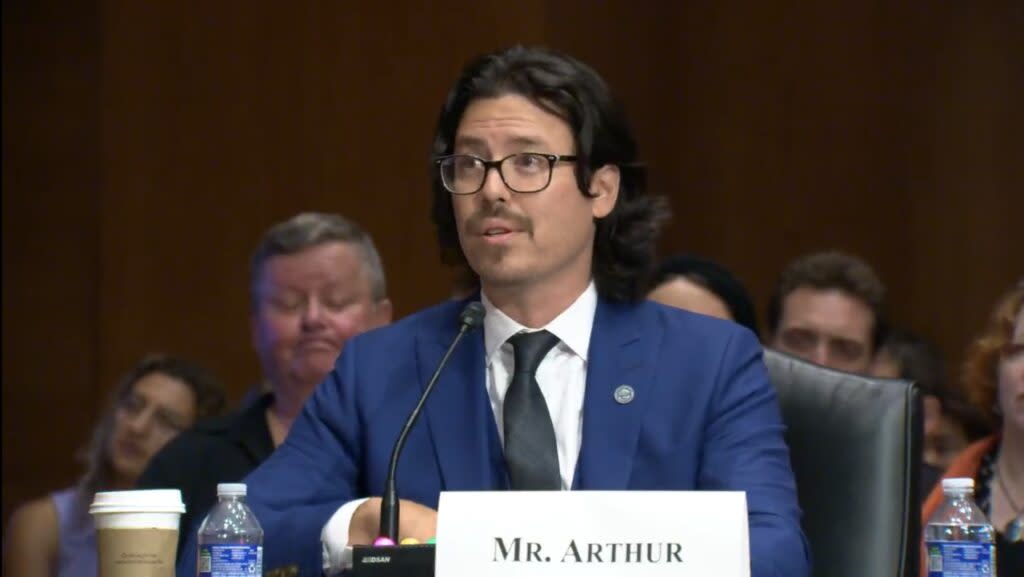‘Extremely low pay’ cited at U.S. Senate hearing as prime reason for teacher shortage

- Oops!Something went wrong.Please try again later.
John Arthur, a teacher at Meadowlark Elementary in Salt Lake City, Utah, testified before the Senate Health, Education, Labor and Pensions Committee in Washington, D.C., on Thursday, June 20, 2024. (Screenshot from committee webcast)
WASHINGTON — The only reason John Arthur is able to be a public school teacher is because his wife makes much more money than he does.
Arthur — the 2021 Utah Teacher of the Year — testified on Thursday at a hearing in the U.S. Senate Committee on Health, Education, Labor and Pensions on the challenges facing public school teachers.
Arthur, who is also a member of the National Education Association and holds National Board Certification, pointed to pay as the main reason for both teachers leaving the profession and parents not wanting their children to become teachers.
“The No. 1 solution to addressing the issues we face must be increasing teachers’ salaries,” said Arthur, who teaches at Meadowlark Elementary School in Salt Lake City, Utah.
Gemayel Keyes, a teacher at Gilbert Spruance Elementary School in Philadelphia, told the committee that even as an educator, he still has an additional part-time job.
The special education teacher spent most of his career in education as a paraprofessional. At the time he moved into that role, the starting annual salary was $16,000 and the maximum was $30,000.
“It’s still pretty much the same,” he said.
Minimum teacher salary
Committee Chairman Bernie Sanders, a Vermont independent, introduced a bill in March 2023 that would set an annual base salary of $60,000 for public elementary and secondary school teachers.
“We understand that the children, young people of this country, are our future and there is, in fact … nothing more important that we can do to provide a quality education to all of our young people, and yet, for decades, public school teachers have been overworked, underpaid, understaffed, and maybe most importantly, underappreciated,” Sanders said in his opening remarks.
“Compared to many other occupations, our public school teachers are more likely to experience high levels of anxiety, stress and burnout, which was only exacerbated by the pandemic,” he said.
Sanders said 44% of public school teachers are quitting their profession within five years, citing “the extremely low pay teachers receive” as one of the primary reasons for a massive U.S. teacher shortage.
For the 2023-24 school year, a whopping 86% of K-12 public schools in the country documented challenges in hiring teachers, according to an October report from the National Center for Education Statistics.
Maryland sets $60,000 minimum
But a minimum annual teacher salary of $60,000 is not far off for every state.
In Maryland, the Blueprint for Maryland’s Future raises the starting salary for teachers to $60,000 a year by July 2026.
William E. Kirwan, vice chair of Maryland’s Accountability and Implementation Board, said the multi-year comprehensive plan, passed in 2021 in the Maryland General Assembly, “addresses all aspects of children’s education from birth to high school completion, including most especially, the recruitment, retention and compensation of high quality teachers.”
Kirwan said the “Blueprint’s principle for teacher compensation is that, as professionals, teachers should be compensated at the same level as other professionals requiring similar levels of education, such as architects and CPAs.”
An “allocation issue”
Sen. Bill Cassidy, ranking member of the committee, dubbed Democrats’ solution of creating a federal minimum salary for teachers as a “laudable goal.”
But he noted that “the federal government dictating how states spend their money does not address the root cause of why teachers are struggling to teach in the classroom.”
“More mandates and funding cannot be the only answer we come up with. We must examine broken policies that got us here and find solutions to improve,” the Louisiana Republican said.
Nicole Neily, president and founder of Parents Defending Education, a parents’ rights group, argued that “schools don’t have a resource issue” but rather an “allocation issue.”
“There’s a saying: ‘Don’t tell me where your priorities are, show me where you spend your money, and I’ll tell you what they are.’ Education leaders routinely choose to spend money on programs and personnel that don’t directly benefit students,” said Neily.
Neily pointed to a 2021 report from the Heritage Foundation, which found that “standardized test results show that achievement gaps are growing wider over time in districts with (chief diversity officers).” Such staff members commonly encourage efforts at diversity, equity and inclusion in schools.
Robert Pondiscio, a senior fellow at the conservative-leaning American Enterprise Institute, said “higher pay does not ease the burden we place on teachers or add hours to their day.”
“By all means, raise teacher pay, but do not assume that it will solve teacher shortages or keep good teachers in the classroom. Poor training, deteriorating classroom conditions, shoddy curriculum and spiraling demands have made an already challenging job nearly impossible to do well and sustainably,” he added.
SUPPORT NEWS YOU TRUST. GET THE MORNING HEADLINES DELIVERED TO YOUR INBOX
The post ‘Extremely low pay’ cited at U.S. Senate hearing as prime reason for teacher shortage appeared first on Oklahoma Voice.

